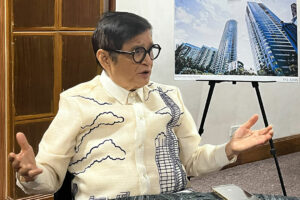THE PHILIPPINES needs to address inefficient land use, improve urban planning, and establish “smart” cities in the countryside to achieve first-world status by 2050, according to veteran architect and urban planner Felino A. Palafox, Jr.
“Looking at Metro Manila, [I noticed] that there are so many wrong land uses in the wrong places, and at the wrong time,” said Mr. Palafox, founder of architecture and urban planning firm Palafox Associates, during the company’s 36th anniversary event on Tuesday.
“Planning is about balance — a balance between jobs and housing, and between land use and transportation,” he said.
Mr. Palafox cited Goldman Sachs, which earlier projected that the Philippines will become the world’s 16th largest economy by 2050.
This also aligns with Palafox Associates’ “Philippines 2050: A First-World Country, A First-World Economy” campaign, which envisions the Philippines as a first-world nation by 2050.
By 2050, over 100 million Filipinos will live in cities, Mr. Palafox said. To accommodate this growing population, the country will need at least 100 new smart, inclusive, and resilient cities, he noted.
“We should encourage more development there [in the countryside], and to stop being Metro Manila-centric. Let’s make the Philippines polycentric,” he said.
Addressing the country’s recurring flooding issue is a key aspect of urban development, Mr. Palafox said, noting that progress has been limited by aging infrastructure and insufficient government response.
“We plan from ridge to reef — top of the mountain, highlands, midlands, lowlands. That’s where you address it before the floods come,” he said.
The country’s waterways have long been unable to accommodate high volumes of rainwater, Mr. Palafox also said.
He cited Super Typhoon Ondoy in 2009, during which over 4,600 cubic meters (m³) of water per second flowed down from the mountains. Since the Pasig River could handle only 600 m³ per second, the excess water — more than 4,000 m³ per second — flooded Metro Manila, causing widespread destruction and thousands of deaths.
To better manage stormwater, the country should consider investing in rainwater harvesting systems and SMART (stormwater management and road tunnel) tunnels.
A SMART tunnel, which has been adopted in countries like Malaysia, diverts floodwater caused by heavy rain into a bypass tunnel.
“During the worst flood, the whole SMART tunnel can be used as spillway,” Mr. Palafox said.
The Philippine government must also focus on solving corruption, criminality, poverty, and poor infrastructure, he added.
Extending the term of foreign leases to 99 years would also help open up the economy and entice more foreign expansion in real estate, Mr. Palafox also said.
He also attributed shortfalls in the country’s urban planning and infrastructure development to inconsistent governance, especially when a different public official is elected.
“We should have a continuous planning system where even if you have a different mayor or governor, the planning system is there,” he said. — Beatriz Marie D. Cruz
